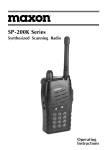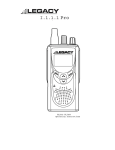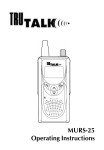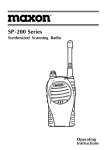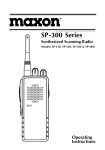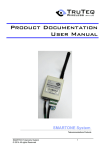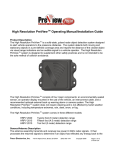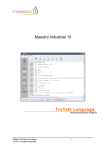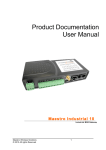Download Maxon GMRS-50 User`s guide
Transcript
GMRS-310 User’s Guide Topaz3, LLC 10828 NW Air World Drive Kansas City, Missouri 64153 www.topaz3.com Toll-free: 800-821-7848 Phone: 816-891-6320 Fax: 816-891-8815 e-mail: [email protected] (end of document) Printed in China U.S. P/N: 680-090-2034 Table of Contents 1. About Your GMRS-310 Radio 2. RF Exposure 3. FCC Information 4. FCC Licensing Information 5. About Topaz3 6. Package Contents 7. Product Use and Care 8. Belt Clip Attachment 9. Battery Installation 10. Controls and Functions • GMRS-310 Radio • LCD Display 11. Basic Operation • Power On/Off and Volume Adjustment • P-T-T (Push-to-Talk) Button • MONITOR / SCAN Function • Backlight Function • LOCK Function • CALL Function 1 • Channel Selection & CTCSS Sub-Code Selection • Dual Channel Scan Function • HI / LOW Transmit Power • CALL Signal Settings • BEEP Sound / Silent Mode Setting • “Roger” Beep Function • VOX Function • Optional Ear Bud Speaker Microphone Use • Optional Battery Charging 12. Maintenance 13. Troubleshooting 14. Specifications 15. Channel Frequency List 16. CTCSS Sub-Code Frequency List 17. Warranty Service Instructions 18. Warranty 2 1. Introduction Before using your new GMRS-310 radio, please read this User’s Guide so that you can take full advantage of all the features of the radio. The GMRS-310 is a lightweight, palm-sized radio that you can carry almost anywhere; while hunting, fishing, camping, hiking, at shopping malls, amusement parks, or sports events to keep in touch with family and friends. Using the GMRS-310 does not require a monthly service fee - the radio can be used anywhere as allowed by the FCC. To insure proper communications with other radios, they must be on the same channel and CTCSS (Continuous Tone Controlled Squelch System) sub-code as your GMRS-310. The channel is the radio frequency wave your radio uses to transmit and receive on. The 3 CTCSS sub-code helps reduce unwanted chatter on the same radio channel, and gives you more channel choices for increased privacy. The GMRS-310 operates on both General Mobile Radio Service (GMRS) and Family Radio Service (FRS) channels. Refer to the Channel Frequency and Sub-Code Lists (Sections 15 and 16) for channel and CTCSS sub-code choices. 2. FCC RF Exposure Compliance The Federal Communications Commission (FCC), with its action in General Docket 93-62, November 7, 1997, has adopted a safety standard for human exposure to Radio Frequency (RF) electromagnetic energy emitted by FCC regulated equipment. This radio subscribes to the same safety standard for the use of its products. Proper operation of this radio will result in user exposure far below 4 the Occupational Safety and Health Act (OSHA) and Federal Communications Commission limits. 3. FCC Information The FCC requires that you be advised of certain requirements involving the use of this radio. This equipment has been tested and found to comply with the limits for a Class B Digital Device, pursuant to Part 15 of the FCC Rules and Regulations. These rules are designed to provide reasonable protection against harmful interference with other electronic devices in a residential environment. This equipment uses and can generate radio frequency (RF) energy. If not used in accordance with the instructions, it may cause interference to other radio communications. However, there is no guarantee that the interference will not occur in another device’s reception (which can be determined by turning the equipment off and on). The user is 5 encouraged to correct the interference by one or more of the following measures: • Reorient or relocate the receiving antenna • Increase the separation between the radio and other devices • Consult the manufacturer for technical assistance FCC Warning: This equipment generates or uses radio frequency energy. Changes or modifications not expressly approved in writing may cause harmful interference and void the user’s authority to operate this equipment. 4. FCC Licensing Information Before using your Maxon GMRS-310, you must obtain / possess a radio license issued by the Federal Communications Commission (FCC). It is illegal to transmit without the appropriate license. 6 The GMRS-310 operates on General Mobile Radio Service (GMRS) frequencies, which are allocated by the FCC for personal uses, including recreation and travel. For more information regarding the licensing application, contact: the FCC’s Consumer Center at 1-888-CALL-FCC (225-5322). To obtain a FCC license to operate your GMRS-310 radio, you must submit FCC Form 605 (main form) plus Form 605 Schedule F (temporary); also Form 159 Remittance Form (for payment of fees) directly to the FCC at this address: Federal Communications Commission Wireless Bureau Application P.O. Box 358130 Pittsburgh, PA 15251-5130 You are required to have in your possession a current copy of Part 95 of the FCC Rules and Regulations before operating your radio. It is your responsibility to insure your radio operates in accordance with the guidelines established by the FCC. You should familiarize yourself with Part 95 of the FCC Rules before operating your radio. To obtain current FCC forms and filing instructions, you can: • Have the forms mailed to you by calling the FCC Forms Distribution Center 1-800-418-FORM (3676). • Have the forms faxed to you by the FCC’s Fax Information System by calling 1-202-4180177. 7 To obtain current a copies of FCC Rules Part 95, contact: Superintendent of Documents Government Printing Office Washington, DC 20402-9371 or by phone: 1-888-225-5322 (8:00 AM to 4:00 PM EST, Monday thru Friday, excluding Holidays). 8 Many larger metropolitan areas have U.S. Government book stores. Check the business listings of your local telephone directory under “Government Book Stores” for listings and locations. 5. About Topaz3 Topaz3 is the exclusive supplier of Maxon, Legacy and TruTalk brand communication products. Our product line ranges from two-way radios suitable for Business and Industry (B&I) markets like farm, Government, law enforcement, utility, etc. to consumer communications equipment for recreational and light-duty business markets. modules, as well as FRS (Family Radio Service), GMRS (General Mobile Radio Service) and MURS (Multi Use Radio Service) radios, Citizen’s Band radios and weather monitors. Available accessory items include a variety of carrying cases, spare batteries, desktop and mobile chargers, ear bud speaker microphones and more for each radio model. For additional information on our product line, visit our website: www.topaz3.com. Product offerings include a variety of UHF and VHF handheld and mobile radios, repeaters and RF link 9 10 6. Package Contents GMRS-310 Radio 7. Product Use and Care Ear Bud Speaker Microphone Do not expose the radio to long periods of direct sunlight, nor place the radio close to heat generating sources. Avoid shaking or dropping the radio. Belt Clip Hand-Strap User’s Guide GMRS-310 User’s Guide Avoid extreme exposure to water and cold. Do not grab or carry the radio by the antenna - accidental breakage may occur. Do not hold the antenna when the radio is in use, as holding the antenna affects the effective range. When using rechargeable batteries, make sure they are fully charged before using the radio. 11 12 8. Belt Clip Attachment 1) Align the belt clip to the mounting rails on the back of the radio. 2) Slide the belt clip downward until it locks into place. To remove the belt clip - lift the lever at the top of the clip while pulling the belt clip upward. 9. Battery Installation NOTE: The GMRS-310 requires 4 AAA batteries (not included). The radio must be powered OFF before installing or removing batteries. NOTE: After removing the belt clip, open the battery compartment cover using the steps below. NOTE: The belt clip must be removed to install batteries into the radio. 1. Push down on the top center of the battery compartment cover and slide away from the 2. Lift the battery compartradio. ment cover off. 3. Insert 4 AAA batteries. Match the battery polarity with the design within the battery compartment. 13 4. Align the battery compartment cover to the rails on radio and slide forward until cover snaps into place. 14 10. Controls and Functions GMRS-310 Radio 15 1. Speaker 2. LCD Window 3. ENTER Button: Selects and enters functions from the menu. When not in the function menu it is used to send the CALL signal. 4. 5/b(UP/DOWN) Buttons: Use to select the function options, scroll through channels and sub-codes. 5. Microphone 6. FUNCTION Button: Use to select a desired function menu. Press and hold it to lock the buttons. 7. P-T-T (Push-To-Talk) Button: Press and hold to talk on the radio. 8. MONITOR / SCAN Button: Press and hold to hear other radio traffic. Press and release to scan channels. 9. Power/Volume Knob: Turns the radio on/off, and adjusts the radio volume. 10. Antenna 11. External Speaker Microphone / Charger Jack: Plug ear bud speaker microphone or optional battery charger into this jack. 16 LCD Display TX BUSY 1. CALL: Appears when the radio is sending a CALL signal to other person. 2. VOX: Appears when the VOX (voice operated transmission) feature is activated. 3. SCAN: Appears while channel scan is active. 4. BEEP: Appears when the BEEP function is on (and silent mode is off). 5. LOCK: Appears when the button lock function is activated. 6. Battery: Shows your battery life / level. 7. PRIV: Appears when a CTCSS sub-code (01 ~ 38) is used. 8. Displays the CTCSS sub-code (01 ~ 38) or the current CTCSS frequency in use. 17 “00” indicates that no CTCSS sub-code is set. 9. TX: Appears while radio is transmitting a message (the P-T-T is pressed). 10. BUSY: Appears while monitoring channels or receiving a message. DO NOT transmit while this icon is visible. 11. Displays the current channel number (1 ~ 22) or the current channel frequency. 11. Basic Operation Power On/Off and Volume Adjustment 1) Power On Turn Power/Volume knob clockwise. 2) Power Off Turn Power/Volume knob counterclockwise, until a click is heard (detent). 3) VOLUME adjustment Increase volume by turning Power/Volume knob clockwise. Decrease volume by turning the Power/Volume knob counterclockwise. 18 P-T-T (Push-To-Talk) Button 1) DO NOT transmit [P-T-T] when receiving a call or when the “BUSY” icon is seen in the display. 2) To transmit, push and hold the P-T-T button. When the “TX” icon appears in the LCD, begin speaking in a normal tone into the microphone. Release the P-T-T button once you have finished your message, and wait for the other person to respond. 3) Once the person you called has responded, you can return a response by pressing the P-T-T button and continue the conversation by repeating the step above. MONITOR / SCAN Function 1) MONITOR Function a. Press and hold the MON (monitor) button to temporarily remove a CTCSS sub-code programmed on a channel and to listen to (monitor) other radio traffic on that channel. This function is also useful for adjusting radio volume. b. If there is no message being received, 19 background noise is heard and the “BUSY” icon will show in the display. 2) SCAN Function a. Press and release the MON button to activate the channel scan function. b. When scanning, the “SCAN” icon will be shown in the display and channel numbers will be scrolling. c. While in scan, the direction in which the channels are scanned can be changed. Press the 5 to scan “up” channel numbers, or press b to scan “down” channel numbers. d. During scan, if a transmission is made while not receiving a call, you will transmit on the channel you selected before entering scan. If a call is received during scan, you will be able return a message (transmit) on that same channel. Scan will resume approximately 5 seconds after your message has been completed. e. Press and release the MON button again to stop channel scan. 20 Backlight Function With radio on, press and release the [F],5, or b button to light the display for 5 seconds. LOCK Function 1) Press and hold the [F] button to lock the [F], 5 , and b buttons, preventing any accidental change of channels and tones and also prohibiting the scan function. The “Key” icon will be shown in the display. 2) Press and hold the [F] button again to unlock the [F],5, and b buttons. CALL Function Press and release the ENTER button to send a call signal out to alert another radio user you are preparing to “call” them (transmit). Channel Selection & CTCSS Sub-Code Selection 1) Channel Selection (1~22) a. Press and release the [F] button once. The channel number will begin to blink. b. Select a channel by using the 5, or b button while the channel number is blinking. 21 c. Once your desired channel is displayed, press and release the ENTER or the P-TT button to save your channel selection. 2) CTCSS Sub-Code Selection (01~38) a. Press and release the [F] button 2 times. The sub-code number will begin to blink. b. Select a sub-code tone by using the 5, or b button while the tone code number is blinking.(If ‘00’ is selected you can receive a signal regardless of the other radio user’s sub-code setting.) b. Once your desired sub-code is displayed, press and release the ENTER or the P-TT button to save your sub-code selection. “PRIV” appears when a CTCSS sub-code is selected. 3) Channel Frequency Designation You may view the channel and CTCSS subcode by either channel / sub-code number or by frequency. Press the [F] and ENTER buttons at the same time to change the display from a channel number to the MHz frequency designation of that channel (example: “462.6125” instead of “3”). 22 To return to the channel number display, press the [F] and ENTER buttons at the same time again. NOTE: When the radio is set to display by frequency, Channel and CTCSS sub-code programming will also display by channel frequency and sub-code frequency as referenced on the Channel Frequency List and CTCSS Sub-Code Frequency List. Dual Channel Scan Function This function allows you to alternately scan between two selected channels. 1) Press and release [F] button once and use 5 , or b to select the first of the two channels. 2) Once the channel has been selected, press and release the [F] button 2 more times, (“DCH OFF” will be blinking in the display). 3) Use 5, or b to select the second scan channel. 4) Press and release the ENTER button to store the two scan channels, and enter the 23 dual channel scan mode. The radio will now begin scanning between the two selected channels. 5) To cancel the dual channel scan function, press and release the MON button. HI/LOW Transmit Power 1) Press and release the [F] button 4 times to enter the HI/LOW power setting. 2) The display will blink either “tPr Hi” (transmit power high) or “tPr Lo” (transmit power low). 3) Use the 5, or b button to select “tPr Hi” or “tPr Lo”. Press the ENTER button to save. Low power is useful for extending the life of your batteries and should be used at close distances. NOTE: Channels 8~14 are permanently set to “tPr Lo” and cannot be changed due to FCC regulations. CALL Signal Settings 1) Press and release the [F] button 5 times to enter the CALL signal setting. 2) The display will blink “CAL 1”. 24 3) Use the 5 , or b to scroll through the possible call signal sounds [CAL 0] ~ [CAL 5]. 4) Once the desired Call signal has been selected, press the ENTER button to save. BEEP Sound / Silent Mode Setting 1) Press and release the [F] button 6 times to enter the beep sound setting or silent mode (no beep sounds from radio). 2) The display will blink “bP ON” or “bP OFF”. 3) Use the 5, or b to select “bP ON” or “bP OFF”. 4) Once selected, press the ENTER button to save. NOTE: When beep is active, the “musical note” icon will be displayed. “Roger” Beep Function This function transmits a “beep” tone upon release of the P-T-T button, alerting the party you have called that your message is complete. 25 1) Press and release the [F] button 7 times to enter the “Roger Beep” setting. 2) The display will blink “rb ON” or “rb OFF”. 3) Use the 5, or b button to select “rb ON” or “rb OFF”. 4) Once selected, press the ENTER button to save. VOX Function VOX (Voice operated transmission) is a function which allows you to talk without pressing the P-T-T button. Your voice “sends” the message instead. To activate VOX: 1) Press and release the [F] button 8 times to enter VOX setting. 2) Use the 5, or b button to select “Vo on”. 3) Press the Enter button to adjust the VOX Sensitivity. 4) “SEN 1” will be blinking in the display. 5) Use the 5, or b button to select “SEN 1” ~ “SEN 10”. The “SEN 1” setting is the most sensitive, “SEN 10” is the least sensitive. 6) Once the desired sensitivity setting is selected, press the ENTER button to set the VOX Delay (dLY). 26 7) “dLY 150” will be blinking in the display. This is the VOX delay time in which your radio stays in the transmit mode during VOX operation. Select between 0.25 seconds [dLY 025] to 4 seconds [dLY 400]. Once selected, press the ENTER button to save your settings. Optional Ear Bud Speaker Microphone Use When the optional ear bud speaker microphone is plugged into the jack at top of radio, the radio’s internal speaker and microphone will be disconnected. Optional Battery Charging An optional wall-type charger is available for use with the GMRS-310, sold separately. When this optional charger is plugged into the jack at top of radio, rechargeable batteries can be installed and used in the GMRS-310. 27 12. Maintenance Your GMRS-310 radio is designed to be maintenance-free. To keep the radio in good working condition: • Clean external surfaces with a clean cloth dampened in a solution of dishwasher detergent diluted in water. Apply sparingly to avoid any moisture leaking into cracks and crevices. Do not submerge the radio. Dry the surface thoroughly with a soft, lint-free cloth. • DO NOT use solvents or spirits for cleaning they may permanently damage the housing. 28 13. Troubleshooting 14. GMRS-310 Radio Specifications RF Impedance 50 Ohm Radio does not power on. 1. Confirm that batteries are installed. 2. Confirm that your batteries are fresh, and not discharged. 3. Confirm that the battery polarity is correct. Frequency Range 462.5625 MHz ~ Audio is not heard over the speaker. 1. Press monitor and confirm that the speaker sounds. 2. Confirm that the volume has not been turned down. 3. Confirm you are on the same channel and using the same Channel Spacing 12.5KHz Number of Channels 22 Modulation System FM Symptom Solution Audio is not clear. Sub-code as the person you are calling. Poor reception. BEEP sound is not heard. 1. 2. 3. 4. Confirm whether batteries are weak. Change transmit power setting to high (tPr Hi) Move closer to the person you are speaking. Move to a higher elevation. Confirm BEEP sound has been turned on . 467.7250MHz (Frequency Modulation) Maximum RF Output Power (Conducted High 2W / Low 0.5W) Operating Temperature -4 F ~ 122 F “BUSY” icon shows but Confirm that your radio’s sub-code matches the sub-code NO reception is heard. of the radio you are calling. Continual transmission in VOX. Confirm that your VOX Sensitivity level (SEN) is not set to lowest number (SEN 1). This level may be too sensitive for your voice or environment. VOX mode does Confirm that your VOX Sensitivity level (SEN) is not set to not activate. the highest number (SEN 10). This level may not be sensitive enough for your voice or environment. High 0.5W / Low 0.15W (-20 C ~ 50 C) Dimensions (H x W x D) 6.375” x 2.125” x 1.3125” (162mm x 54mm x 33mm) Weight (with batteries) 4.9 oz. (139g) Battery Requirements AAA size, 4 batteries “Broken” 1. Confirm that the VOX delay time is not set to the lowest transmissions when number (dLY 025). A Delay setting of 175 to 225 will using VOX mode. generally work well for most users. 29 30 15. Channel Frequency List (MHz) Channel Frequency Channel Frequency 1 462.5625 12 467.6625 1 67.0 14 107.2 27 167.9 2 462.5875 13 467.6875 2 71.9 15 110.9 28 173.8 3 462.6125 14 467.7125 3 74.4 16 114.8 29 179.9 4 462.6375 15 462.5500 4 77.0 17 118.8 30 186.2 5 462.6625 16 462.5750 5 79.7 18 123.0 31 192.8 6 462.6875 17 462.6000 6 82.5 19 127.3 32 203.5 7 462.7125 18 462.6250 7 85.4 20 131.8 33 210.7 8 467.5625 19 462.6500 8 88.5 21 136.5 34 218.1 9 467.5875 20 462.6750 9 91.5 22 141.3 35 225.7 10 467.6125 21 462.7000 10 94.8 23 146.2 36 233.6 11 467.6375 22 462.7250 11 97.4 24 151.4 37 241.8 12 100.0 25 156.7 38 250.3 13 103.5 26 162.2 FRS Channel are 1 ~ 14 above; FRS Channels 8-14 are restricted to 0.5W (500mW). All other channels are GMRS frequencies and are 2W (Hi) or 0.5W (Low) operation. 31 16. CTCSS Sub-Code Frequency List (Hz) Code Frequency Code Frequency Code Frequency 32 17. Warranty Service Instructions 1) Refer to this User’s Guide for proper operation and adjustments. 2) If the problem cannot be corrected by reference to this User’s Guide, return the product with proof of purchase (a sales receipt) to the place of purchase, or call Topaz3’s Customer Service Department for assistance, toll free: 1-800-821-7848, Ext. 499. For Your Records Purchased From: 17. Warranty Statement Topaz3, LLC warrants that each new GMRS310 radio product manufactured or supplied by it to be free from defects in material and workmanship under normal use and service for One (1) year. Any accessory item packaged with the GMRS-310 radio shall carry a Ninety (90) Day warranty. This Warranty is void for sales and deliveries outside of the U.S.A. or Canada. To obtain a full written warranty statement, contact the Topaz3 Customer Service Department: 1-800-821-7848, Ext. 499. Purchased From: Serial Number: KEEP THIS INFORMATION IN A SAFE PLACE. 33 34


















